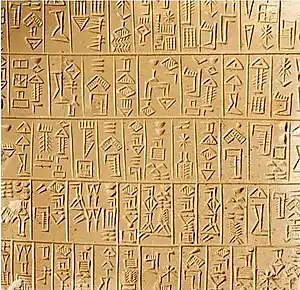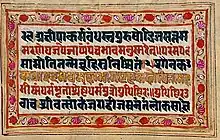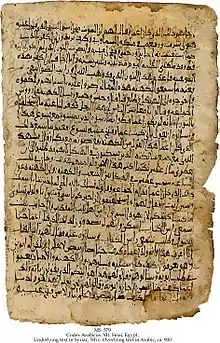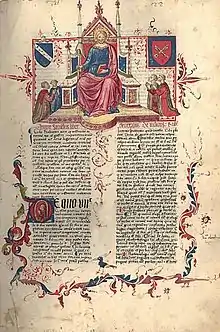Schøyen Collection
The Schøyen Collection is one of the largest private manuscript collections in the world, mostly located in Oslo and London.[1] Formed in the 20th century by the father of current owner Martin Schøyen,[2] it comprises manuscripts of global provenance, spanning 5,000 years of history. It contains more than 13,000 manuscript items; the oldest is about 5,300 years old. There are manuscripts from 134 different countries and territories, representing 120 languages and 185 scripts.[3][4]
The Collection procures and preserves diverse manuscripts, from all over the world, irrespective of the geography, culture, linguistic, race and religious background. It declares that its interest is in "advancing the study of human culture and civilization" over many millennia.[4] Some of its recent acquisitions have been obtained from the civil war-affected regions of the Middle East and Afghanistan, where warlords and smugglers have destroyed ancient sites to find a buyer for ancient manuscript fragments and artifacts.[5]
Controversies
One of the controversies with Schøyen Collection has been whether its acquisitions through the black market transactions encourage further reckless destruction of ancient sites, illegal abuse of heritage sites, and the financing of terrorists or Civil War chieftains.[6] Iraq and Afghanistan, for example, have sought a return of certain recently acquired items in the Schøyen Collection.[7] The Collection states that it "strongly supports a tough regime for cultural protection", makes active effort towards pro-active compliance with the law and is an "ethical private collector in preserving the heritage of all mankind".[8]
The provenance of the various cuneiform materials held by the Schøyen Collection has been subject to controversy.[9]
The Schøyen Collection has been a party to the controversy surrounding 654 Aramaic incantation bowls.[10] They were alleged to belong to Iraq, alleged to have been stolen after August 1990, brought to Jordan, resold by a local art dealer named Ghassan Rihani, and through intermediaries purchased by the Collection.[10] The Schøyen Collection then provided University College London the bowls for an academic study. Activists alleged in 2003 that the items were stolen from Iraq and illegally traded, and it must be returned to Iraq. The University set up a panel to investigate the claims in 2004, and the Schøyen Collection sued the University for the bowls.[8] The Schøyen Collection denied that these bowls were stolen or smuggled, providing official documents issued by the government of Jordan as evidence that the Jordanian source owned it prior to 1965.[10] University College London settled, paid an undisclosed amount in compensation, suppressed its own report on the provenance of the bowls, and returned the items back to the Schøyen Collection.[10][11]
Notable manuscripts
The Schøyen Collection preserves some of the oldest known archaeological discoveries and manuscripts.
Ancient world
- MS 1717 (31st century BC), The Kushim Tablet, a Sumerian cuneiform record of beer production, signed by possibly the first example of a person named in writing[12]
- MS 2064 (21st century BC), Ur-Nammu's law-code, a Sumerian text.[13]
- MS 2781 (2000–1600 BC), a Babylonian calendar.[14]
- Tutankhamun's signet ring
- MS 108 "The earliest Greek Alphabet” copper,, Cyprus, ca. 800 BC, 2 tablets, 21x13 cm, single column, (19x10 cm), 20-23 lines in archaic Greek capitals with some North Semitic (Phoenician) letter forms by 2 or more scribes.
- MS 5236, an ancient Greek block print from the 6th century BC
- Ancient Buddhist and Hindu manuscripts likely recovered from recently destroyed Buddhist sites such as Bamiyan in Afghanistan and other Buddhist monastery ruins in northwest Pakistan since the 1990s.[15][16]
- MS 193 (3rd century AD), The Crosby-Schøyen Codex, biblical manuscript in the Coptic language; it contains: Jonah, 2 Maccabees, 1 Peter, "Peri Pascha" of Melito, and an unidentified Homily[17]
- MS 2650 (4th century AD), Codex Schøyen, the oldest Gospel of Matthew in Coptic dialect[18]
- Since 1994, the Schøyen Collection has acquired 115 Dead Sea Scrolls fragments from 15 different scrolls.[19]
- MS 035, Codex Sinaiticus Zosimi Rescriptus, a palimpsest on vellum from Mount Sinai[20]
Medieval and modern era
- MS 1 (c. 1300), a fragment from a codex of French sermons, in a binding produced by Manuale del Navarro, acquired in 1955
- MS 4457 (1865-1879 AD), Cheyenne Chief Little Shield's Ledger Book recording the Indian War of the Platte River in 1865.
- Manuscripts related to Buddhism, Hinduism, Jainism and Sikhism
References
- Sophia Labadi; Colin Long (2010). Heritage and Globalisation. Routledge. pp. 146–147 note 13. ISBN 978-1-136-96526-5.
- https://snl.no/Sch%C3%B8yen-samlingen
- The Schøyen Collection
- Scope & Size of the Schoyen Collection
- Derek Gillman (2010). The Idea of Cultural Heritage. Cambridge University Press. pp. 12–15. ISBN 978-0-521-19255-2.
- Noah Charney (2016). Art Crime: Terrorists, Tomb Raiders, Forgers and Thieves. Springer. pp. 169–173. ISBN 978-1-137-40757-3.
- Juliette van Krieken-Pieters (2006). Art and Archaeology of Afghanistan: Its Fall and Survival : a Multi-disciplinary Approach. Brill Academic. pp. 238–240. ISBN 978-90-04-15182-6.
- SCHØYEN COLLECTION SUES UNIVERSITY COLLEGE LONDON FOR RECOVERY OF INCANTATION BOWLS, 9 March 2007
- Robson, Eleanor (1 May 2017). "Review of: The Babylonian Gilgamesh Epic: Introduction, Critical Edition and Cuneiform Texts, 2 vols". Bryn Mawr Classical Review.
- Inside the hunt for Iraq’s looted treasures, Richard Hall, The Independent (July 10, 2019)
- Balter, Michael (2007). "University Suppresses Report on Provenance of Iraqi Antiquities". Science. American Association for the Advancement of Science (AAAS). 318 (5850): 554–555. doi:10.1126/science.318.5850.554. S2CID 33011586.
- Ms 1717 at the Schøyen Collection
- Ms 2064 Archived 2018-01-29 at the Wayback Machine at the Schøyen Collection
- The Middle Babylonian Almanac at the Schøyen Collection
- Stephen C. Berkwitz; Juliane Schober; Claudia Brown (2009). Buddhist Manuscript Cultures: Knowledge, Ritual, and Art. Routledge. pp. 9–12. ISBN 978-1-134-00242-9.
- Jens Braarvig (2000). Buddhist manuscripts, Vol 1–3. Hermes. pp. xii–xiii, 102–105, 275–285. ISBN 978-82-8034-003-0., Volume 1: ISBN 978-82-8034-001-6
- Ms 193 at the Schøyen Collection
- Ms 2650 at the Schøyen Collection
- Dead Sea Scrolls at the Schøyen Collection
- Ms 035 at the Schøyen Collection. Forms only a third of the Codex of which the major part is stored in the National Library of Russia and additional new finds were made in the Monastery of Saint Catherine Christa Müller-Kessler, Codex Sinaiticus Rescriptus. A Collection of Christian Palestinian Aramaic Manuscripts, Le Muséon 127, 2014, pp. 263–309; Sinai, Georgian NF19; Georgian NF 71 Sinai Palimpsest Project.



